1) Almindingen
2) Dueodde
3) Ertholmene
4) Hammeren and Slotslyngen
Almindingen
In the centre of Bornholm
Large forest area. Three bogs that are among Bornholm’s best wetland areas, with a varied birdlife.
See Google map with bird observation towers, etc.
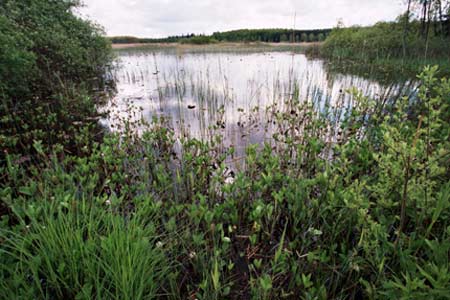
Bastemosen
Description:
The name “Almindingen” (which means “the common”) dates from the time when this hilly, rocky landscape, which was mostly heath and scrubland, was used by ordinary people for grazing cattle. Today, the area comprises both large conifer forests, large areas of deciduous woodland, and several bogs and forest lakes. The biggest bogs are Ølene, Bastemose and Svinemose. Ølene is a boggy area with a shallow lake, old peat ponds and large meadows. Bastemose is fairly overgrown with reedbeds and willow scrub. Svinemose mostly resembles a peat bog with reedbeds. A new raised bog, Hagemyr, has recently been re-established.
Several areas in Almindingen are preserved as “untouched” forest and grazing pastures. In the eastern part of the area there are several open areas with heather. Almindingen is one of Denmark’s largest stretches of forest.
Birds:
Breeding birds:
Bornholm was long known as the only breeding locality in Denmark for Tengmalm’s owl and was the first place in the country to have breeding black woodpeckers. Unfortunately, the black woodpeckers have disappeared again, but Tengmalm's owl is hopefully still breeding here, helped by the 40 nesting boxes that have been put up in the IBA area (Almindingen and Rø plantation). From 2009, between one to five pairs of Tengmalm’s owl have been breeding in this area, but in 2021 no breeding birds were found. This was also the case in 2022, but there were three singing males.
There are many other breeding birds in Almindingen which make the locality an interesting one. For example, it is an important breeding site for crane, marsh harrier and red-backed shrike.
The forest supports breeding crane, honey buzzard, goshawk, woodcock, nightjar, tree pipit, redstart, wood warbler, pied flycatcher, treecreeper and red-backed shrike, together with the more common forest birds. Redcrest is now seen regularly in the area south of Rytterknægten.
Greylag goose, marsh harrier and crane breed in the Ølene bog. Now and again, teal, pintail and garganey also breed here. Breeding waders include lapwing, snipe and green sandpiper. In addition, there are many breeding passerines, including long-tailed tit and goldfinch. In Svinemosen, little grebe, red-necked grebe, tufted duck and marsh harrier breed, together with many of the same bird species as in Ølene, including crane. This also applies to Bastemose. In the bogs there are also waterbirds such as water rail, moorhen and coot, and other birds such as thrush nightingale, reed warbler and reed bunting. Crane, marsh harrier and red-backed shrike breed at Vallensgårdmose. Penduline tit has been seen in the area. Hagemyr houses red-necked grebe, little grebe, greylag goose and ducks. On the edge of the bog there are breeding little ringed plover, whinchat and red-backed shrike. In Vallenskær bog there are around 10 pairs of breeding lapwing. Up to 2 pairs of hobby breed in the area and are mostly seen over Bastemose throughout the summer. White-tailed eagle nests in the plantations to the east.
Migrating and staging birds:
During the migration period, many raptors visit the bogs, for example hen harrier, goshawk, sparrowhawk, buzzard, osprey, kestrel and red-footed falcon. Hobby is often seen hunting over the bogs. Peregrine are seen regularly in Ølene, where there is also a good chance of seeing white-tailed eagle, that is a regular visitor, and golden eagle, which turns up in the winter months.
In April and September, especially, thousands of cranes can be seen flying over the area, first on their way to their breeding grounds in Sweden and then to their winter quarters in Spain and Northern Africa. In September, the area houses flocks of swallows and martins that roost for the night in the reedbeds. Previously, flocks of starlings roosted in the bogs, but for some years now they have been settling for the night outside Almindingen, mostly in Åkirkeby. Various waders visit Ølene during the migration period. Mute swan, whooper swan, Bewick’s swan and greylag goose use the bogs as wintering sites. Udkæret, just south of Almindingen, between Springbakkevej and Gulbakkevej, is an important staging area for crane, waders, geese and ducks. Many waders use Vallenskær for staging, and it is also an important staging post for several species of goose and for cranes.
Other animals:
Bornholm has a large population of roe deer, that were reintroduced onto the island in 1885. It may be of interest to note that there are no foxes on Bornholm (probably exterminated by mange), nor are there any martens or moles.
In 2012 a group of European bison (the largest mammal living in the wild in Europe today) were introduced into an area south of Rømersvej.
Visiting and access:
There is easy access to most of the area, as there are many public roads that cut through the locality. Many car parks and picnic sites offer fine starting points for walks in the area, and there is a net of forest trails and footpaths. At Ølene there are three bird observation towers, of which the newest, on Rømersvej, is disabled-friendly. At Bastemosen there is a 5m high observation tower with a ramp for wheelchairs. A new tower at Vallensgårdsmose (Kærgårdstårnet), accessible from Skørrebrovej, gives a good view over the bog and over Vallenskær. Hagemyr can be reached on foot, but one can park on the roadside at Nydamsvej. It is recommended to use the Nature Agency’s folder about the area which can be downloaded here or the google map (link above).
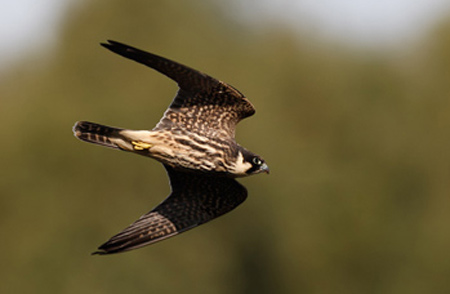
Hobby. Photo: Helge Sørensen
Dueodde
The southernmost tip of Bornholm
Bornholm’s best locality for autumn migration
See Google map with car park etc.
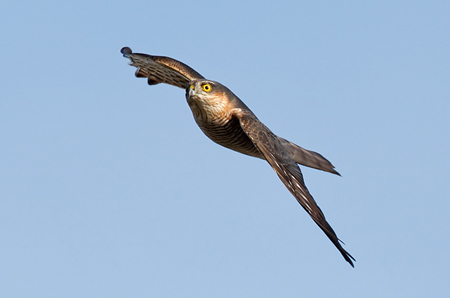
Sparrowhawk. Photo: Helge Sørensen
Description:
The spit of Dueodde is dominated by a sandy beach, which in some places is up to 100m wide, and which changes form according to wind and weather. In several places, small lagoons are formed. Behind the beach is an area with shifting sand and dunes, and further inland is Strandmarken, a large plantation laid out in the 1870s to stop the sand drift. It consists mostly of mountain pine and Scotch pine. There are many holiday cottages in the plantation. Near the southernmost tip of the spit is the 47m high, slender Dueodde lighthouse.
Birds:
Migrating and staging birds:
Migration starts in August, when swallows, sand martins and a few raptors begin their journey south. In September, migrating larks, pipits, wagtails, thrushes, goldcrests, tits and siskins appear (once over 8000 birds were spotted on one morning), together with large flocks of chaffinch and brambling. Dueodde is renowned for over 1000 mistle thrushes in one day. Now and again a few nutcrackers can be spotted. Finches and siskins continue to migrate into October, when there is also a chance of seeing flocks of migrating cranes. The record is 7000 on one day.
More uncommon birds include red-throated pipit (several each year), Lapland bunting (several each year), Richard's pipit (some years), little bunting (very rare), greenish warbler and red-breasted flycatcher (more common). In September 2021 a brown booby was spotted here - a new bird species for Denmark.
Many raptors fly out over the sea from Dueodde but seldom in large numbers, apart from sparrowhawk and rough-legged buzzard, which on some days have been seen in numbers of over 100. Kestrel were seen in record numbers in 2017 with over 135 birds flying out from the coast on one day. Other raptors include honey buzzard, red kite, buzzard, osprey, merlin and hobby.
Seabirds move along the coast in fair numbers. Little gull is seen regularly - now and then in large numbers. In addition, divers, cormorants, widgeon, tufted duck, eider and common scoter can be spotted over the sea. Geese also fly along the coast and sometimes white-fronted geese and barnacle geese can be seen in their hundreds.
Visiting and access:
On the Søndre Landevej between Rønne and Snogebæk there are signs to Dueodde. From the road connecting Pedersker, Dueodde and Snogebæk there are several minor roads leading to car parks near the coast (for example next to the lighthouse).
At the T-junction Dueoddevej/Strandmarksvej a road (Fyrvej) leads off to the car park at the lighthouse.
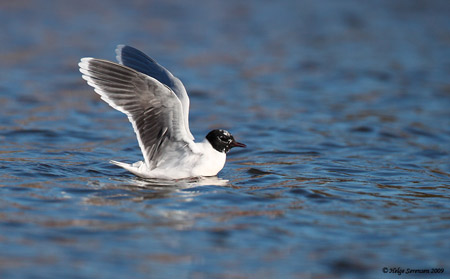
Little gull. Photo: Helge Sørensen
Ertholmene
Islands north-east of Bornholm
Important stopping point for tens of thousands of night-migrating passerines. Large colony of eider, and Denmark’s only colony of razorbill and guillemot.
See Google map
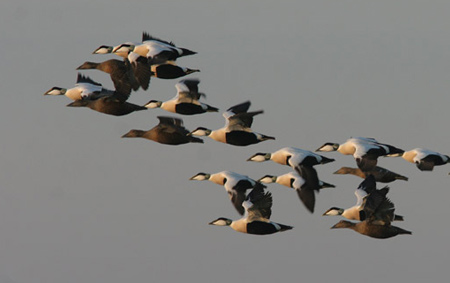
Eiders. Photo: Klaus Malling Olsen
Description:
The ground rock of the islands of Ertholmene is granite. The two largest islands – Christiansø and Frederiksø – are inhabited. Christiansø is 710m long and 430m wide and is surrounded by 300 year old fortress walls from the time when the island was of military importance. Most of the buildings are grouped together down by the harbour. In the middle of the island is a group of tall trees and bushes, but otherwise vegetation is sparse, with only a little heath and a few small ponds and reedbeds. The third island, Græsholm, which has scarcely any vegetation, is a bird reserve. The waters around the coast are brackish with a salinity of only 0.8%.
Breeding birds:
The islands are an important breeding locality for eider, razorbill and guillemot. The eider population was formerly much larger, culminating in 1992 with 3000 nesting females. After that, the population has decreased considerably, with a total of only 958 nesting birds registered in 2022. However, this number now appears to be stable. It has not been established with certainty what the cause of this dramatic drop can be, but a possible reason can be lack of food.
The only Danish colonies of guillemot (around 4900 pairs) and razorbill (1200 pairs) are situated on Græsholm, where there is also a large colony of herring gull. In contrast to the eider population, the breeding population of razorbill has increased. Small numbers of common gull, lesser black-backed gull and great black-backed gull nest on the islands together with red-breasted merganser. Scarlet rosefinch sometimes breed.
Migrating and staging birds:
Being a little group of islands far out in the sea, Ertholmene is a typical locality that attracts migrating birds. The spring migration culminates in April and May, and autumn migration is in full swing from the end of July to around November. April sees the arrival of dunnock, robin, song thrush and goldcrest and later, in May, the islands house thousands of warblers. Thrush nightingale, bluethroat, icterine warbler, lesser whitethroat, garden warbler, blackcap, greenish warbler, wood warbler, willow warbler, spotted flycatcher, red-breasted flycatcher, pied flycatcher and ortolan bunting are seen regularly.
Rarities that are seen nearly every year include Blyth’s reed warbler, subalpine warbler, Radde’s warbler, dusky warbler, rustic bunting and little bunting. During autumn migration it is not unusual to see Pallas’s leaf warbler and yellow-browed warbler. In autumn, cranes (sometimes up to 6,000-7,000 birds) and barnacle geese and brent geese pass over the islands.
The best time to see migrating birds is actually in foggy weather, as passerines “fall” on the islands and wait until visibility has improved before moving on.
In winter, the islands are a good viewpoint for observing seabirds, including eider and long-tailed duck, and with some luck perhaps a random king eider or stellers eider. Purple sandpiper are seen on the coast.
The number of grey seals observed around Ertholmene has risen quite considerably since 2007, when 3 seals were observed. Since then up to 470 animals have been registered. The seals can mostly be seen near the skerry of Tat north of Græsholm, but sometimes they come close to the coast of the inhabited islands. Most of the grey seals are seen in April/May.
The small ponds dotted about the island, which are used for collecting rainwater, are home to four species of amphibean: common toad (Bufo bufo), green toad (Bufo viridis), marsh frog (Rana ridibunda) and smooth newt (Triturus vulgaris).
A ferry sails from Gudhjem on Bornholm once a day all year round. In the summer months (beginning of May to end of September) there are also several trips every day from Gudhjem and Allinge. By taking the first ferry in the morning from Bornholm and the last ferry in the evening from Christiansø, one has several hours on the island to go bird-watching. However, it is an exciting experience to spend the night on the island and enjoy the peace and quiet when the last of the day tourists have left. This needs some planning, however, as there is only one inn on the island and only a very small camp site, so booking needs to be done well in advance.
In the Lilletårn tower on Frederiksø is a natural history exhibition with an emphasis on birdlife.
It is permitted to walk around on Christiansø and Frederiksø, but it is preferable to keep to the paths. There is no access to Græsholm or the many islets during the birds’ breeding season. However, one can easily look across to Græsholm from the area north of Lilletårnet on Frederiksø.
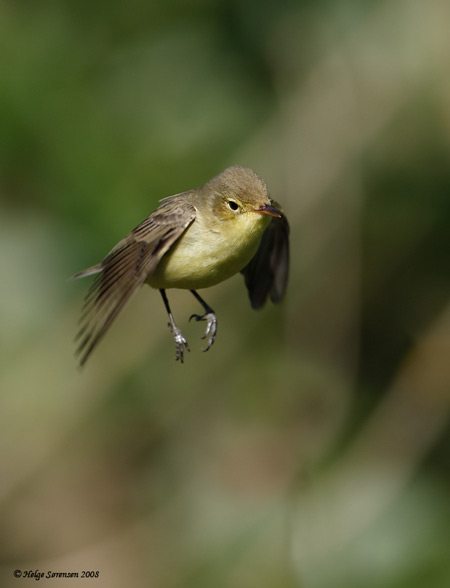
Hammeren and Slotslyngen
Bornholm
Bornholm’s best locality for spring migration and Denmark’s only bird cliffs
See Google map with car parks, look-out points, etc.
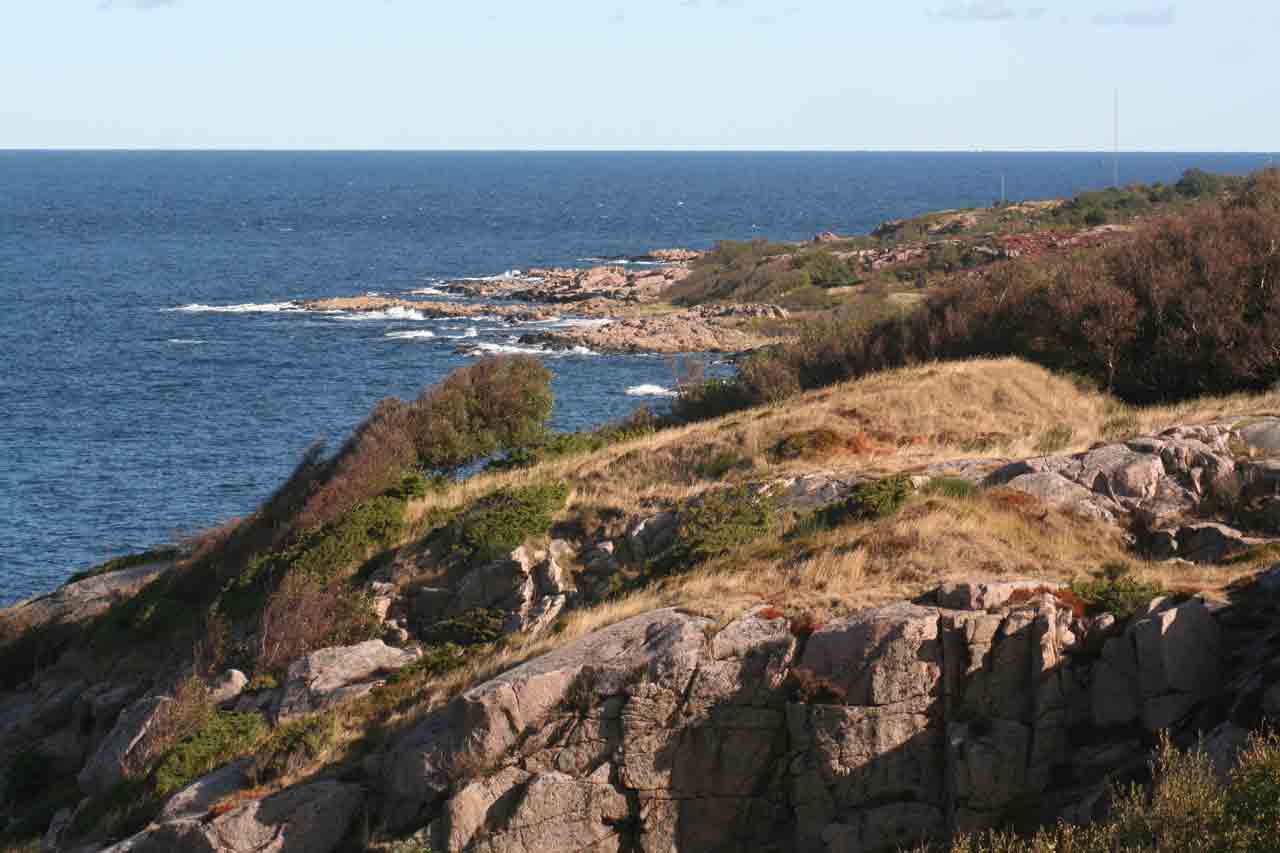
Hammeren in autumn. Photo: Carsten Andersen
Description:
Hammeren is the northernmost point of Bornholm. It is an enormous rock smoothed down by the glaciers of the last ice age, and is separated from the rest of the island by a joint-valley in which lies Bornholm’s largest lake, Hammersø. The area is mostly heath dominated by heather with some bushes and low trees. Vegetation is kept down by grazing sheep.
To the south is the Slotslyngen heath: originally all heather, but now some trees are springing up. The ground is very hilly and comprises joint-valleys, cliffs and marsh. The southern part consists of dry grassland and heath grazed by sheep. The coast here is formed of steep cliffs.
Birds:
Breeding birds:
Hammeren is one of the first localities in Denmark where peregrine falcon began to breed again after many years’ absence. It started nesting on the cliffs at Slotslyngen in 2006. There are now two pairs in the area. The cliffs also support razorbills, which started to breed here in 1996 - again after many years’ absence. In April, one can spot the razorbills swimming in formation out on the sea from the path over Mulekleven. During the past few years, guillemot has also returned to breed and can now be seen together with the razorbills in flocks of over a hundred birds quite near to the coast. The cliffs are also a nesting site for herring gull, jackdaw, starling and a few pairs of Baltic lesser black-backed gull.
On the dry grasslands one can find icterine warbler and red-backed shrike as well as a few pairs of scarlet rosefinch. The open areas on the Slotslyngen also house a few nightjars and most years serin. In the woods, all the common woodland birds can be found, together with some more uncommon species such as buzzard, goshawk, sparrowhawk, woodcock, raven, lesser spotted woodpecker, stock dove and hawfinch and also a dense population of wood warbler. Greenish warbler regularly establishes territories in the area.
Migrating and staging birds:
Most birdwatchers come to see the spring migration, when large flocks of birds fly past on their way to breeding grounds further north. Among the migrating and staging birds one can be lucky enough to see some more uncommon species that come from more easterly regions.
Cormorants, divers, auks and diving ducks – especially eider and common scoter – can be seen moving over the sea, together with many barnacle geese and cranes. Over the land is an impressive migration of passerines, especially corvus species, pigeons, thrushes and finches. Ringed ouzel is sometimes seen in the flocks of thrushes. On good days, many wheatears and whinchats rest here – they are easily spotted in the open country. Great grey shrike also favours this habitat. Several rarities are spotted nearly every year, for example red-breasted flycatcher and scarlet rosefinch. Raptor migration is on a lesser scale and consists mostly of buzzards and sparrowhawks, but now and again a more uncommon species turns up. Black kite has been seen regularly the past few years.
Autumn can also be a good time to go birdwatching on Hammeren. In July/August, when north-west winds are blowing, there can be a relatively good migration of waders. Many passerines can be seen, and also barnacle geese and cranes. When the wind is coming from the north-west, large flocks of seabirds are blown closer to the coast and their numbers usually exceed those seen at Dueodde at the south-eastern corner of Bornholm.
Visiting and access:
Spring migration can be watched from several spots. Sea migration can best be seen from the outermost point, Hammer Odde, just north-west of the lighthouse. Raptor migration can be watched from Hjortebjerg, the highest point on Hammeren, not far from the car park north of Sandvig. To reach the car park, turn off from Strandgade in the middle of the village to continue along Sandlinien, past a camp site, and along the bay. The car park is at the end of the road. From here, a surfaced road leads out to the lighthouse, or one can walk up over the hills on a path leading from the car park.
Around Hammerfyr (the lighthouse at the southern end of Hammeren) there are open areas from where one can watch migration. One can park at the lighthouse. It is reached by turning off Hammershusvej at the south western edge of Sandvig and driving along Hammersøvej towards the lighthouse.
The largest castle ruin in northern Europe, Hammershus, is situated a little further south on Slotslyngen. The best way to reach Slotslyngen, however, is from the car park on Finnedalsvejen, ½km north of Vang. The walk here is very imposing, with bare cliffs on one’s right and a marvellous view across the Baltic Sea on one’s left. It is a very special experience to see the bird cliffs from the sea, which can be arranged with the boat service at Hammerhavn.
It is a good idea to use the map in the Nature Agency’s folder covering northern Bornholm.
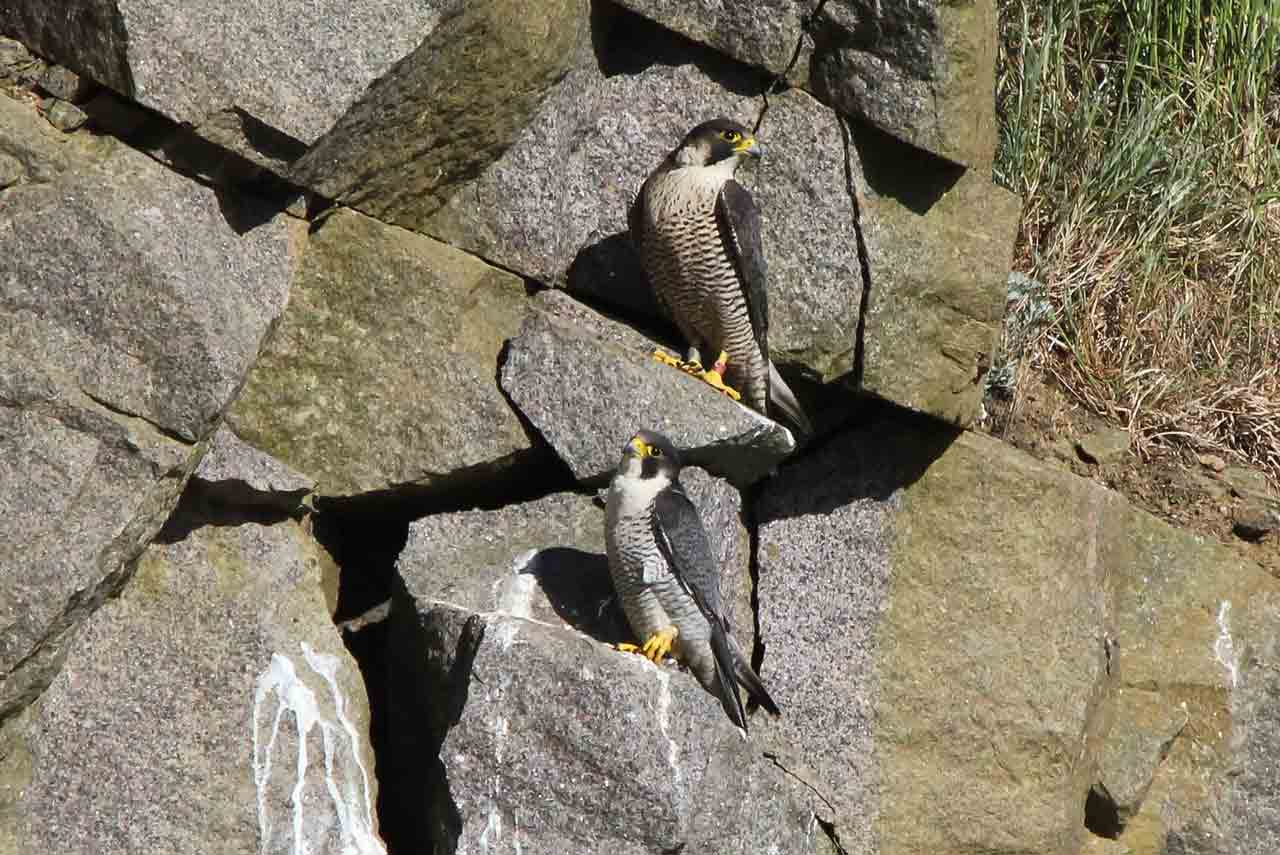
Peregrine falcons at Vang granite quarry. Photo: Carsten Andersen